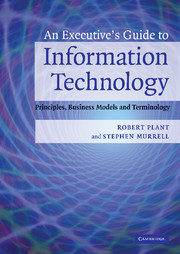Book contents
- Frontmatter
- Contents
- Introduction
- A ACM (Association for Computing Machinery) to Audio
- B Backup to Business process re-engineering
- C C, C++, C# to Cracking
- D Database to Dynamic web pages
- E e-Commerce/e-business to European Union Directive on Privacy and Electronic Commerce 2002
- F Fiber optics to Fuzzy logic
- G to H Global positioning system to Hypertext, HTML
- I ICANN (Internet Corporation for Assigned Names and Numbers) to ISP (Internet service provider)
- J to L Java to Logic programming
- M Machine learning to Multicast
- N Natural language processing (NLP) to Normalization
- O Object-oriented to Outsourcing
- P Packet switching and circuit switching to Public key-private key
- Q to R Quantum computing to RSS (Really simple syndication)
- S Sarbanes-Oxley Act of 2002 (SOX) to Structured design methodologies
- T to U T-Carrier to URL (Uniform resource locator)
- V Value added network (VAN) to Voice over IP (VoIP)
- W W3C (the World Wide Web Consortium) to WYSIWYG
- X to Z X.12 to Zip
- Index
- References
G to H - Global positioning system to Hypertext, HTML
Published online by Cambridge University Press: 17 May 2010
- Frontmatter
- Contents
- Introduction
- A ACM (Association for Computing Machinery) to Audio
- B Backup to Business process re-engineering
- C C, C++, C# to Cracking
- D Database to Dynamic web pages
- E e-Commerce/e-business to European Union Directive on Privacy and Electronic Commerce 2002
- F Fiber optics to Fuzzy logic
- G to H Global positioning system to Hypertext, HTML
- I ICANN (Internet Corporation for Assigned Names and Numbers) to ISP (Internet service provider)
- J to L Java to Logic programming
- M Machine learning to Multicast
- N Natural language processing (NLP) to Normalization
- O Object-oriented to Outsourcing
- P Packet switching and circuit switching to Public key-private key
- Q to R Quantum computing to RSS (Really simple syndication)
- S Sarbanes-Oxley Act of 2002 (SOX) to Structured design methodologies
- T to U T-Carrier to URL (Uniform resource locator)
- V Value added network (VAN) to Voice over IP (VoIP)
- W W3C (the World Wide Web Consortium) to WYSIWYG
- X to Z X.12 to Zip
- Index
- References
Summary
Definition: Also known as Navstar GPS, an electronic device that may rapidly and accurately determine its own geographical location by receiving signals from a network of orbiting satellites.
Overview
There are a few dozen special-purpose satellites, launched and maintained by the US military, in constant Earth orbit. They contain extremely accurate clocks, programmed knowledge of their own orbits (which is constantly corrected by signals from ground stations), and high-frequency radio transmitters. These satellites transmit a constant stream of data, which describes the exact time and their position, and can easily be picked up by terrestrial receivers.
A GPS receiver listens to the stream of data from a number of these satellites, and from it, using relatively simple geometry, can calculate its own exact position (longitude, latitude, and elevation) to an accuracy of just a few feet. These receivers can be made very small (around one square inch) and moderately cheaply (tens of dollars). Their primary use is as an aid to navigation (in aeroplanes, in smart guided missiles, and in hand units for use by people), but they may also be embedded into larger systems. By comparing a sequence of positions, a GPS unit may also determine its own speed and direction of movement, and the relevant portion of a digitized map may be automatically displayed.
Information
- Type
- Chapter
- Information
- An Executive's Guide to Information TechnologyPrinciples, Business Models, and Terminology, pp. 163 - 173Publisher: Cambridge University PressPrint publication year: 2007
